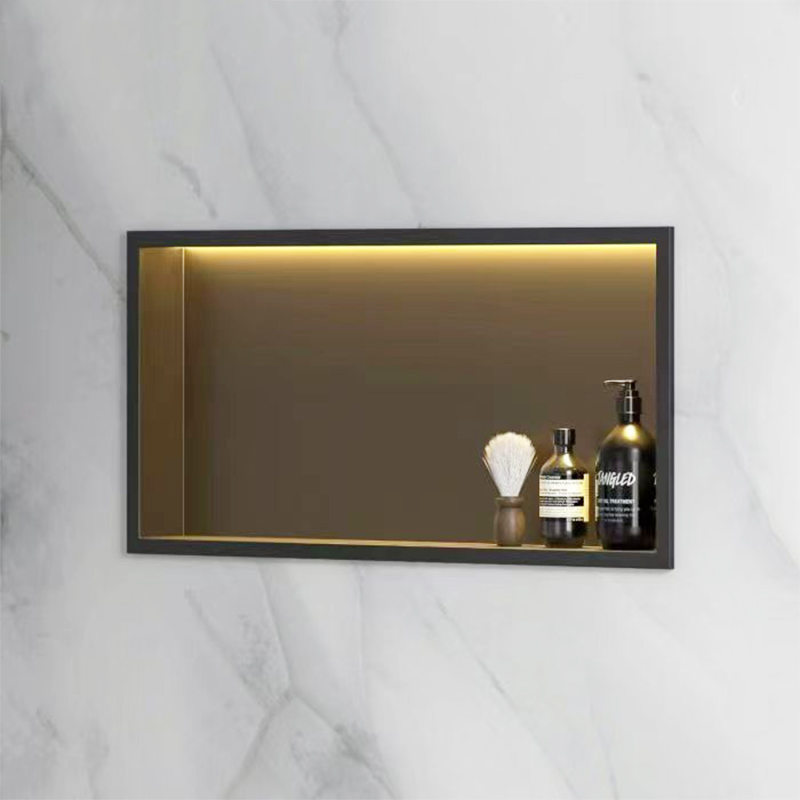Where Should A Bathroom Niche Be Placed?
A bathroom niche is one of the most practical and visually appealing features you can add to a shower or bath area. It provides organized storage while maintaining a clean, uncluttered aesthetic. Yet one of the most common questions during design or renovation is: where should a bathroom niche be placed?
Placement is not only about convenience but also about waterproofing, usability, and balance within the space. In this article, we’ll explore ideal niche locations, height and layout considerations, waterproofing details, design principles, and how modern Wall Niches combine function with style.
1. Understanding the Purpose of a Bathroom Niche
A bathroom niche is a recessed shelf built into a wall cavity, typically in a shower or above a bathtub. It serves as a dedicated storage space for shampoo bottles, soap, and other toiletries. Unlike surface-mounted shelves, a niche sits flush with the wall, preventing clutter and simplifying cleaning.
The key benefits include:
Space efficiency: It maximizes vertical storage without encroaching on the shower area.
Ease of cleaning: Recessed surfaces minimize corners that collect soap residue.
Design flexibility: Niche materials and finishes can accentuate the overall style — from tile to stainless steel or stone.
Water protection: Properly waterproofed niches reduce risks of mold and leakage compared with suction-cup or surface shelves.
In modern bathrooms, the niche has evolved beyond simple storage — it’s a design statement that adds symmetry, function, and even lighting options for ambiance.
2. Ideal Placement Zones for a Bathroom Niche
When planning a niche, location determines both its convenience and longevity. Poorly chosen positions can lead to water retention, accessibility issues, or awkward proportions. Below are the most common and effective placement zones.
In the Shower Wall
The most typical location is on the main shower wall, within arm’s reach when standing under the showerhead. Placing it too close to the water source risks direct spray accumulation, while placing it too far reduces usability. The ideal zone is usually opposite or adjacent to the showerhead, at chest height.
Beside the Bathtub
For bathtubs, a niche is best positioned above the tub rim, where users can reach products comfortably without stretching or bending. Avoid placing the niche too high — it should align with natural hand movements when seated in the tub.
Near the Vanity
A small vertical niche near the vanity or mirror provides space for grooming products, toothbrushes, or decorative items. This is particularly useful in minimalist designs where countertop clutter is avoided.
Within Partition Walls
In larger bathrooms, partial or dividing walls between wet and dry zones provide an opportunity for double-sided niches — functional on both sides, one for shower storage and the other for decorative shelving.
3. Determining the Right Height and Size
The correct height of a bathroom niche depends on the type of users and its specific purpose. A well-positioned niche enhances convenience without interrupting the tile layout or structural framing.
Shower Niches
For adults, the standard height is between 100 cm and 120 cm (39–47 inches) from the floor to the base of the niche. This level is ideal for reaching bottles and soap comfortably. For family bathrooms, consider adding a second lower niche (around 70–90 cm) for children’s items or razors.
Bathtub Niches
Above a bathtub, the niche should start 20–30 cm above the rim, with the center roughly at 120–130 cm from the floor. This ensures reachability while sitting in the tub and prevents splashing directly into the recess.
Multi-Shelf or Vertical Niches
For more storage, vertical niches with two or three compartments are increasingly popular. They allow segregation of tall bottles, soap dishes, and decorative pieces.
| Location | Base Height from Floor | Recommended Depth | Common Width |
|---|---|---|---|
| Shower (Single Tier) | 100–120 cm | 8–10 cm | 30–60 cm |
| Bathtub | 120–130 cm (center) | 8–12 cm | 40–70 cm |
| Vanity Area | 100–110 cm | 6–8 cm | 20–40 cm |
Depth should allow standard bottles to fit while maintaining waterproofing integrity. Avoid overly deep niches that collect water or become hard to clean.
4. Structural and Waterproofing Considerations
The success of a niche depends as much on what’s behind the wall as what’s visible on the surface. Poor waterproofing or improper framing is a common cause of long-term damage.
Avoid Structural Studs
Before cutting into a wall, verify the stud layout. Avoid load-bearing studs or plumbing pipes. Prefabricated stainless steel or ABS wall niches simplify installation since they’re designed to fit between standard 16-inch centers.
Waterproofing Essentials
The interior of the niche must be fully sealed with waterproof membranes or integrated waterproof trays. Corners should have no exposed seams. Using one-piece stainless steel niches eliminates joint failure risks entirely, offering a clean, long-lasting surface.
Slope for Drainage
Ensure the niche’s base slopes slightly (around 1–2°) toward the shower floor to allow water runoff. Even a small amount of standing water can lead to staining or mildew over time.
Tile Alignment
When tiling around the niche, align grout lines with surrounding tiles to create a seamless look. Misaligned joints can disrupt visual balance and draw unwanted attention.
5. Best Wall for Niche Placement
Not every wall is equally suitable for a niche. Selecting the correct wall ensures easy installation and long-term durability.
Interior (Non-Exterior) Walls
Whenever possible, build the niche into interior walls. Exterior walls contain insulation, and cutting into them can compromise thermal efficiency and create condensation problems in colder climates.
Plumbing-Free Walls
Walls free of pipes or wiring make ideal niche locations. Cutting into a wall that houses plumbing increases installation complexity and potential leakage points.
Central or Feature Wall
In open showers, a central niche on the main feature wall can serve as a visual anchor. This placement works particularly well when the niche is accented with contrasting tiles or backlighting.
6. Aesthetic Integration and Tile Design
A niche should feel intentional — not like an afterthought. Its placement should align harmoniously with the tile pattern and bathroom layout.
Aligning with Tile Grout Lines
To maintain symmetry, position the niche so its borders coincide with grout lines. This ensures clean geometry and minimizes awkward tile cuts.
Using Contrasting or Decorative Tile
The back of the niche can use accent tiles, mosaic patterns, or metallic finishes to add depth. This transforms the niche from a simple recess into a design highlight.
Framing and Trim Options
Tile edge trims or stainless steel frames provide protection for tile edges and give a crisp, finished appearance. Some contemporary designs use flush-mounted frames for a minimalist aesthetic.
Lighting Accents
Integrated LED lighting inside the niche adds drama and practicality, especially in darker shower enclosures. Waterproof low-voltage strips create a subtle glow while highlighting decorative surfaces.
7. Horizontal vs. Vertical Niches
The choice between horizontal and vertical orientation affects both function and style.
Horizontal Niches are best for minimalist aesthetics, accommodating multiple bottles side by side. They work well across wide shower walls.
Vertical niches maximize height when wall width is limited. They’re also suitable for separating personal items for different users.
For visually balanced layouts, consider centering the niche horizontally within the shower wall or aligning it with the showerhead’s vertical axis.
8. Prefabricated Niches vs. Custom-Built Designs
Choosing between prefabricated and custom-built niches depends on time, budget, and material preferences.
Prefabricated Niches
Prefabricated stainless steel or waterproof composite niches are factory-sealed and ready for installation. They eliminate guesswork and significantly reduce leakage risk. Their clean edges and sleek design make them ideal for modern bathrooms.
Custom-Built Niches
Masonry or tile contractors can build custom niches for unique layouts or curved walls. Custom designs offer flexibility in size and shape but require expert waterproofing. They can incorporate stone slabs, quartz panels, or patterned tiles for a bespoke look.
Both types can achieve excellent results when installed correctly, but prefabricated models save time and minimize long-term maintenance.
9. Common Mistakes to Avoid
Even well-designed niches can fail if certain details are overlooked. Avoid these frequent errors:
Placing directly under a showerhead: This exposes the niche to constant water flow, causing puddling and mold growth.
Incorrect waterproofing: Using standard drywall instead of moisture-resistant board or membrane leads to deterioration.
Improper height: Niches that are too high or too low reduce usability and comfort.
Uneven slope: Without a drainage angle, water stagnates on the shelf surface.
Ignoring insulation: Exterior wall niches in cold climates can cause condensation or freezing.
By avoiding these mistakes, you ensure that the niche remains both functional and visually refined for years.
10. Trends in Modern Bathroom Niche Design
Contemporary niche design has shifted toward integration and minimalism. Rather than protruding shelves, designers now favor clean recesses that blend into the wall plane. Key trends include:
Full-width niches that stretch across the shower wall, creating horizontal emphasis.
Stainless steel wall niches with seamless construction for durability and hygiene.
Hidden storage panels where a mirror or tile section doubles as a concealed compartment.
Smart lighting integration using motion or humidity sensors for energy-efficient illumination.
Custom materials, such as natural stone or solid surface, creating high-end spa atmospheres.
These innovations demonstrate how functionality can merge with architectural detail, turning a simple utility feature into an elegant focal point.
Conclusion
So, where should a bathroom niche be placed? The answer depends on use, ergonomics, wall structure, and aesthetic goals. The best placement is typically within easy reach, away from direct water flow, and aligned with tile geometry for visual harmony.
Choose a height that matches your comfort level, ensure complete waterproofing, and select materials that resist moisture and complement your bathroom design. Whether using a sleek stainless steel prefabricated model or a custom-tiled recess, a well-placed niche brings both order and elegance to your space.
When designed with precision, a bathroom niche becomes more than just storage — it’s an architectural feature that enhances daily convenience while maintaining a timeless, minimalist appearance.




